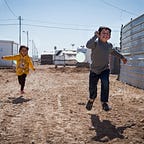Climate Migration — We need to pay more attention to climate refugees
It does not take much imagination to picture a world where changing weather patterns lead to disastrous events such as flooding, hurricanes, wildfires, desertification, drought and sea-level rise. These environmental catastrophes have intensified and become more likely due to climate change, and in return have led to millions of people being forced to flee their homes.
For an example of climate change affecting migration, look no further than Syria. A devastating drought, the worst in 900 years, affected the livelihoods of over 1.5 million farmers in rural Syria almost fifteen years ago. The drought led farmers to migrate from rural to urban areas of the country. It also led to a decimated water supply and disrupted food chains that became widespread in the country. While climate change is not the only factor that impacted migration in Syria, it certainly exacerbated already existing failures in social systems within the country and the extra stresser of the drought acted as a threat multiplier when it comes to political stability. Syria is not isolated in the climate migration phenomenon — people are forced to flee their homes due to changing weather conditions globally. For years, there has been incessant flooding in India, Nepal and Bangladesh, the degradation of local ecosystems in Central America, and detrimental drought in the Lake Chad Basin in west-central Africa. In 2018, 28 million new internal displacements accounted for in the World Migration Report. A staggering “sixty one percent (17.2 million) of these new displacements were triggered by disasters, and 39% (10.8 million) were caused by conflict and violence.”
What’s to come?
While people are forced to migrate due to changing weather patterns now, experts predict that the situation will only worsen over the next few decades. The United Nations forecasts “that there could be anywhere between 25 million and 1 billion environmental migrants by 2050.” With numbers this striking, it is past time that climate change is centered in discussions of migration.
The international community is beginning to pick up speed on addressing climate-related migration. In June 2020, The United Nations High Commissioner for Refugees acknowledged climate change as one of the predominant reasons why refugees flee, however, the definition of “refugee” has not shown the same inclusivity. As of the 1951 Convention Relating to the Status of Refugees, “a ‘refugee’ is defined as a person who has crossed an international border “owing to well-founded fear of being persecuted for reasons of race, religion, nationality, membership of a particular social group or political opinion.” The narrow definition of refugee could exclude those who were forced to flee due to climate change — which is important because the legal status of refugees is meant to safeguard those in most dire need of relocation and provide them legal protection while in another country. This terminology has been rather inconsistent within the international community, some argue that the term “climate migrants’ is most appropriate since most climate-related migration is internal and not necessarily forced, while others note the “protection gap” that the lack of legal status has created for people fleeing environmental devastation. Without having the status of “refugee,” relocation outside of the home country is immensely more difficult. It may be time for the international community to loosen its grip on the existing definition of “refugee,” in order to make legal protection more attainable for all people who need relocation.
Who is impacted most by climate migration?
Climate migration has disproportionately impacted people living in poverty, disabled populations, the elderly and women. More often than not, the most extreme weather events and environmental degradation often happen in the Global South, where countries impacted are less able to cope due to structural constraints. Meaning, countries which are already located in a precarious environment are more likely to experience climate disasters and in turn, are more seriously impacted when an emergency occurs. The same situation is multiplied for vulnerable populations within the climate impacted countries. Those living with disabilities may already be more vulnerable to environmental degradation due to compromised health conditions. Elderly populations are more vulnerable when disaster hits as their mobility may be limited and are often less likely to flee. Women also experience climate change differently than men and are more likely to be vulnerable in terms of protection and livelihoods when forced to migrate. This is due to factors including lack of access to emergency plans, opportunities for relocation within their means, and mobility. This leads to people being chronically hungry, un-housed and un-employed as a result of environmental destruction.
The role of the International Community
Climate change is finally rising to the forefront of the international community, with emerging programs, reporting and data now tailored to climate-related migrations. However, there needs to be a more organized and expedited approach with the international community in unison in order to most successfully equip the field for what’s to come. To implement pathways to safety for all, it is essential that all refugees — including climate refugees — are being recognized with the legal protection which they deserve. After encountering devastating disasters, it is the responsibility of the international community to protect these populations, especially since we know those who are already in some of the most vulnerable contexts are most likely to become climate refugees. Safe migration pathways should be established for people affected by climate change and migration.
Emily Ervin for Refugee Pathways
